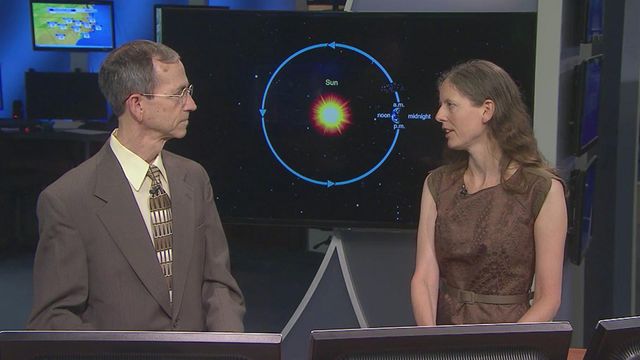Perseid meteor shower peaks early Thursday
The Perseid meteor shower is a favorite among stargazers because of it brings plenty of bright, fast (nearly 60 miles per second) meteors at a time when the weather is warm. This year's shower peaks this week with a sharp increase in meteors Wednesday night into early Thursday morning.
Posted — UpdatedThe Perseid meteor shower is a favorite among stargazers because of it brings plenty of bright, fast (nearly 60 miles per second) meteors at a time when the weather is warm. This year’s shower peaks this week with a sharp increase in meteors Wednesday night into early Thursday morning. Meteors (the streaks of light we see) are created by tiny meteoroids (bits of rock) entering the atmosphere at high speed. Those bits of rock were left by 109P/Swift-Tuttle as it passes through every 133.28 years.
The Perseids are a particularly good shower in part because 109P/Swift-Tuttle reaches perihelion, or the point in its orbit closest to the sun, just 19 days before crossing Earth’s orbital path. As the sun heats the comet, ice transforms directly from a solid to a gas, ejecting lots of dust and bits of rock.
It might seem that these brilliant flashes of light miles up would be created by huge objects but these meteoroids are actually tiny – just a few millimeters across. You might have a good analog in your pantry right now.
“In my exhaustive research on breakfast cereals, I’ve concluded that Grape Nuts cereal is a pretty good analog for a typical meteor particle. They are about the right color, about the right density and about the right size” said Kelly Beaty, editor of Sky and Telescope Magazine at a recent American Meteorological Society Conference held in Raleigh.
Viewing tips
Find a dark place with as few lights illuminating the sky as possible. Take a blanket and maybe a pillow to prop your head up and plan to stay out for at least an hour. Give your eyes at least 10 minutes to adjust to the darkness.
Look to the northeast toward the “W” pattern of the constellation Cassiopeia. Beneath you’ll find the bright star Capella. The radiant point, or point that the meteors appear to come from is about halfway between Cassiopeia and Capella. Meteors can appear anywhere in the sky though, so if there is a glow from light pollution in the northeast for you, look to a darker part of the sky to see more meteors.
In general the number of meteors visible rises from midnight to the beginning of astronomical twilight around 5 a.m when sunlight is first seen in the sky. We see fewer meteors in the hours after sunset because we are on the side of Earth shielded from the debris trail. In the hours before sunrise we are on the side rotating into the debris trail. Think of how wet the front and rear windows of a car get driving through rain.
How many meteors will be visible?
An average of 1 per minute from a dark location is a reasonable estimate but it could certainly be more or less. While 109P/Swift-Tuttle has a very stable orbit, there are still far too many variables to predict how spectacular any year's show might be. Each year we are pass through a different debris stream from a different trip through the solar system by the comet. Those streams change shape as they are subjected to the gravitation tug of the planets, especially Jupiter.
The weather is looking good for the shower’s peak with rainy weather moving out of the area. The National Weather Service forecasts mostly clear skies Wednesday evening into Thursday morning with less than 10 percent of the sky covered clouds during the peak viewing times of 2 a.m. to 5 a.m. Thursday morning. This year’s show should be even better because skies will be dark all night because the new moon does not rise until around sunrise Thursday morning.
The show isn't over as the darkest part of the night ends and meteors become more difficult to see. Between around 5 a.m. and sunrise about 90 minutes later, Mars will be visible low in the east/northeast. You may also catch a rare view of the thinnest of crescent moons rising just before 6 a.m.
Where to view locally
Copyright 2024 by Capitol Broadcasting Company. All rights reserved. This material may not be published, broadcast, rewritten or redistributed.






